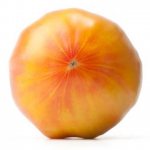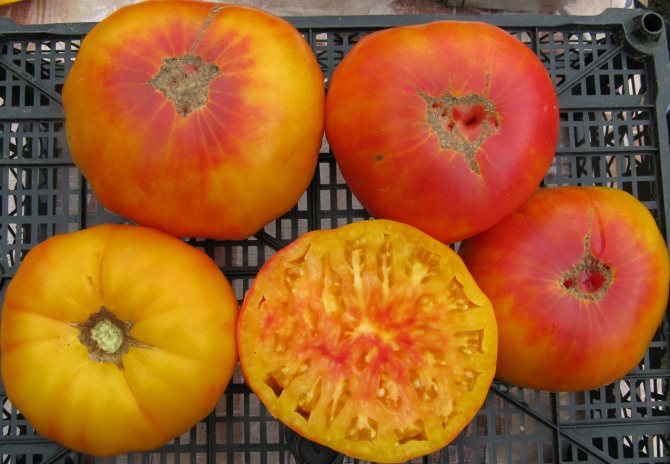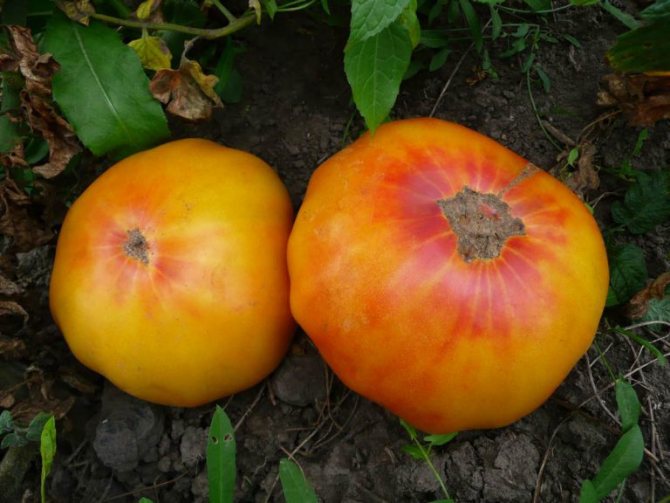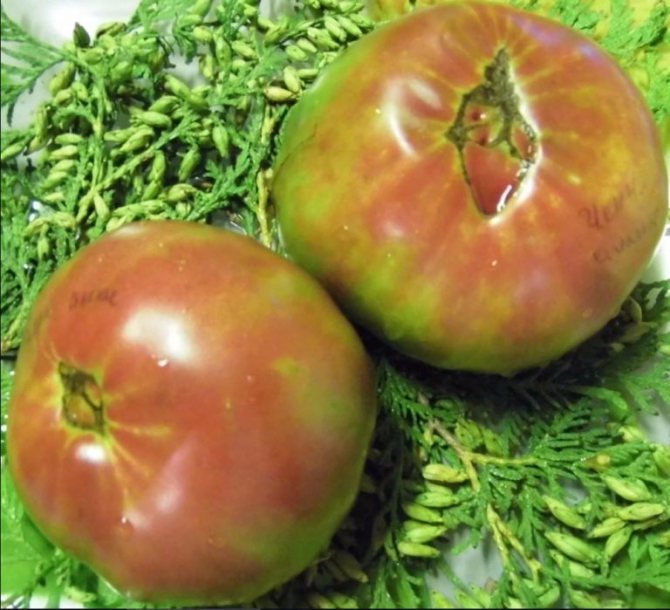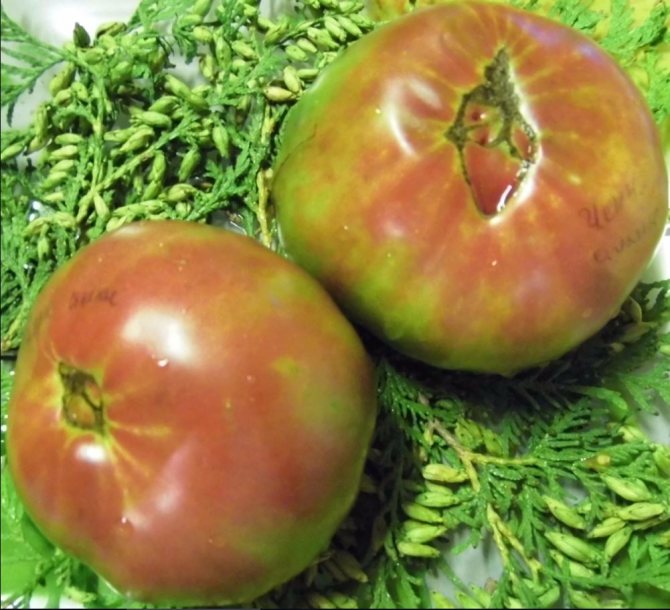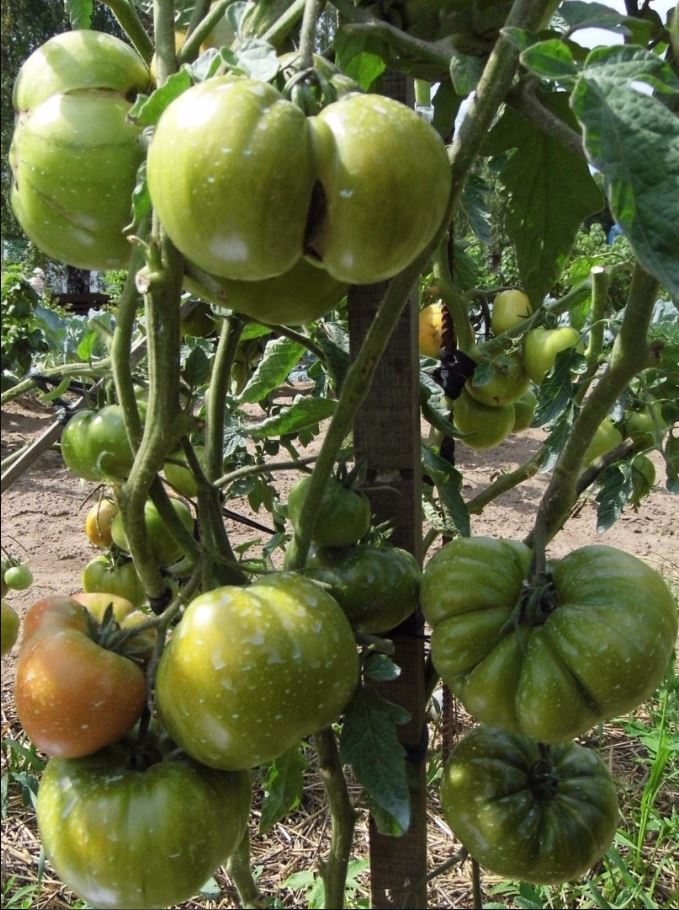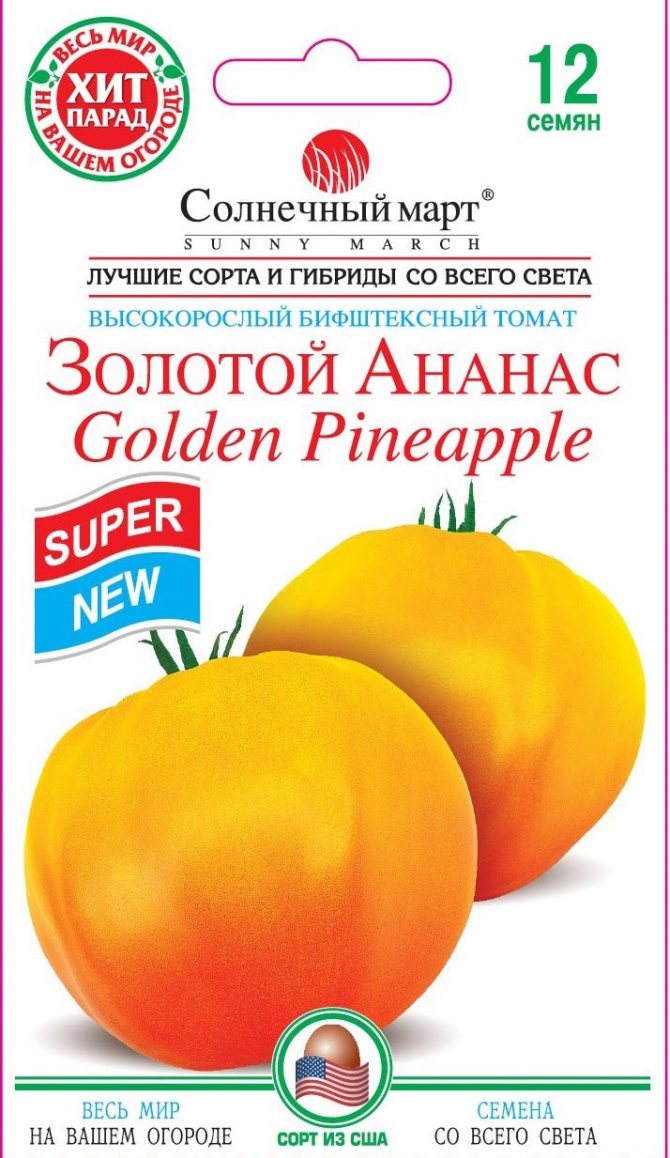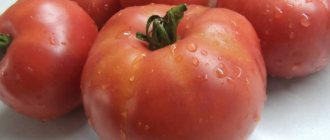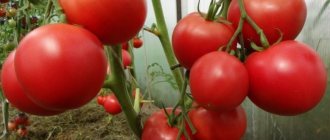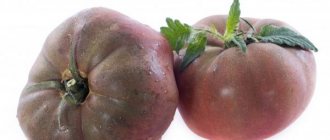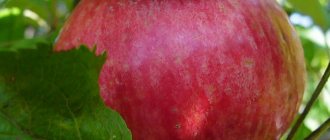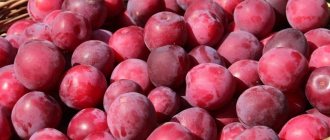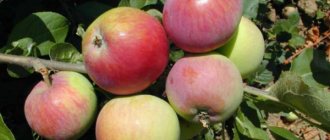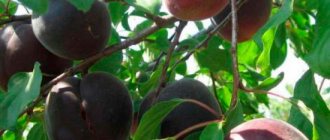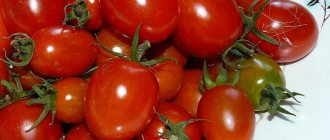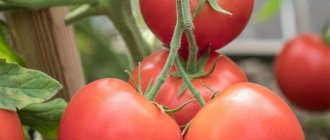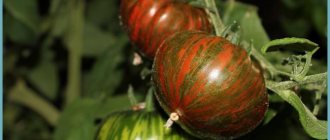Tomato Golden Pineapple (Ananas Gold) is an indented, mid-early variety that differs significantly in its characteristics from other tomatoes. Tomato is popular not only because of its unusual taste, but also attracts summer residents with its non-standard look.
The fruits begin to ripen 115 days after the first seedlings appear. The average height of the bush is two meters. Seedlings require regular pinching and tying to a support. To get a good harvest, gardeners recommend forming bushes into two stems and planting tomatoes only in greenhouses.
Tomato variety Black pineapple
Tomato Black pineapple delights with amazing exotic color and sweet fruity taste. This variety is native to Belgium. Its creator is the gardener and breeder Pascal Moreau. The tomato has not yet been entered into the State Register - it can only be found in the author's collections of gardeners and seed producers.

Tomato variety Black pineapple
Characteristics of the variety
Bushes are of an indeterminate type, usually growing up to 130-150 cm. In greenhouse cultivation, a tomato can reach 200 cm. Fruiting is medium early. The first crops are harvested in mid-July. In fruit clusters, 2 to 6 tomatoes are tied.
Fruit
Despite the name, the color of the tomatoes is by no means black. Usually this is a whole range of shades - a mixture of brownish, red and green.
A unique feature of the fruit is that the variegated color of the skin is repeated on the pulp. In section, they look very impressive and really resemble pineapples.
The taste of tomatoes is sweet, without acid, with fruity notes and aroma.
The fruits are large, from 400 to 700 g. According to the description, when the bush is formed into 1 stem and the ovaries are rationed, the weight of some specimens can reach 1 kg.
The skin of the fruit is thin and dense, the flesh is sugary and quite juicy. The fruits are usually used fresh - for elegant cuts or salads. It is inconvenient to preserve them because of their large size.
Yield
Black pineapple has a high yield - from 6 to 9 kg per bush. However, with a lack of nutrients and unfavorable weather conditions, yields can be sharply reduced.
To increase the performance, it is recommended to form a bush in 1 stem and additional feeding.
Pros and cons of the variety
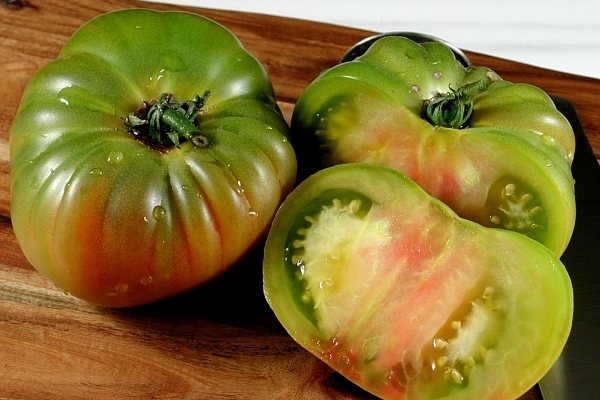

Each fruit crop has its own advantages and disadvantages, the Black Pineapple also has such. You can see them in the table below.
| Positive sides | Negative sides |
| They tolerate transportation well | It is necessary to regularly apply mineral fertilizers |
| High yield | It is necessary to constantly tie up the shoots and install props under them. |
| Unusual fruit color | They are sensitive to temperature fluctuations and changes in humidity. With an abundance of rains, the fruit has a sour taste. |
| Suitable for long-term storage at low temperatures | Not suitable for canning, because fruits are large |
| It is necessary to regularly remove stepchildren |
Advantages and disadvantages
The undoubted advantages of this variety include:
- taste characteristics of fruits and spectacular appearance;
- large-fruited;
- high productivity;
- good keeping quality and transportability.
The disadvantages are the following:
- in a rainy, cloudy summer, the fruits grow sour;
- tomato is picky about soil fertility;
- tomatoes may crack.
Tatiana Orlova (Vasilidchenko) (Candidate of Agricultural Sciences):
There are varieties prone to cracking of the fruit, because they have high intracellular pressure. But it happens that the cause of this phenomenon is a violation of agricultural technology (rare and irregular watering) or weather conditions (heavy rains after hot weather during the ripening of fruits).
Harvesting and storage
Harvesting is carried out at the time of full ripening of the fruit. Since the plant belongs to the early maturing species, in most cases the risk of getting unripe fruits at the end of the growing season is minimized.


When receiving these vegetables, it is recommended to place them in a cool, dark place and eat them as the vegetables ripen.
Landing
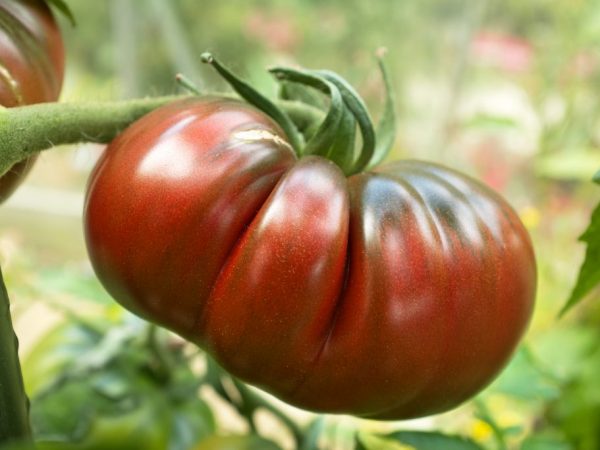

Excellent and delicious tomato
For growing in greenhouses, seeds for seedlings are sown in late February or early March. She will be ready for transplant in 2 months (plus or minus a week). For growing outdoors, crops are sown later - at the end of March or at the beginning of April.
Sowing
Before proceeding with sowing, the characteristics of seed germination are checked: they are placed in a saline solution and those that have floated up are rejected.
Tatiana Orlova (Vasilidchenko) (Candidate of Agricultural Sciences):
This method does not establish the germination of seeds, but only divides them into 2 fractions: full-weight and feeble seeds. Shrunken seeds floating on the surface of the saline solution can also be viable. But the seedlings that have grown from them will be weak and stunted.
Then they are treated with a manganese solution for disinfection.
Seeds of this variety are recommended to germinate before sowing by placing them in a damp cloth for 2-3 days.
Sprouted material is sown in a tray with a soil mixture of peat and turf. Each seed is deepened by 1 cm, and then the sowing is moistened with a spray bottle. The tray is covered with foil or glass and placed in a warm place (at a temperature of 24-25 ° C) until shoots appear.
Features of cultivation and possible difficulties


Tomato Pineapple belongs to the mid-season varieties: in order to get an earlier harvest, the seeds must be planted at the end of March at the beginning of April.
7 days before planting a tomato Pineapple, you need to start hardening the plant. To do this, they are taken out into the fresh air. Every day, the time spent in the open air is increased, for 3-4 days they are left in the air overnight.
When planting a tomato in open ground, do not forget that the plant is tall and there should not be more than 2-3 bushes on one square meter.
Watering the tomatoes should be done carefully and in moderation, otherwise the soil may not only develop a fungus, but also the roots will begin to rot. The plants are fed every two weeks. If you take proper care of the tomato, they will delight you with a bountiful harvest until the fall.
Difficulties in growing tomatoes can be very diverse:
- Seedlings that grow on the windowsill, in favorable conditions, become pampered and when transplanted, it will not be easy for them to adapt. To avoid this, temper the seedlings.
- In seedlings, the leaves turn yellow and dry - these are the consequences of a lack of light or an excess of moisture.
- Plants do not have enough light due to planting pieces too close, and they begin to stretch towards the light.
- If the leaves are limp and saggy, the plant lacks moisture.
- If white spots appear on tomato leaves, then they received a sunburn, but brown spots signal a fungal disease.
To overcome all these difficulties, it is enough to carefully examine the plants and follow the basic rules of caring for them.
Diseases and pests
Diseases and pests affect growth and yield. There are several problems that can be identified by their appearance. All diseases, except fungal, can be prevented or cured by feeding the plant with this or that fertilizer.
But the spread of mold on the plant threatens you with the loss of the entire bush and contamination of the neighboring ones. This is because the fungus spreads rapidly.
But there are several more dangerous diseases and pests that you need to know about:
- Blooming rot on the back of the fruit. It is easy to recognize it: on the back of the fruit there is a dark spot the size of a two-ruble coin. You can get rid of the disease by removing the affected fruits. To avoid a second disease, you need to monitor watering and fertilize the plant with calcium (some gardeners use crushed eggshells as top dressing).
- Flowers are tied, but they fall off and the fruit either does not have time to develop at all, or is very poorly developed. This often happens due to sudden changes in the weather, for example: during the day the temperature was above 35 degrees, and at night it dropped to 10. Mulching will help to avoid the problem.
- Sticky and misshapen leaves. The reason is the pear-shaped aphid. It damages the plant by sucking the juice out of it and leaving behind a sticky substance on the leaves and fruits. In addition to aphids, whiteflies and spider mites can cause the same visible symptoms. Special insecticidal sprays and removal of weeds around the plant will help get rid of pests.
- Cracking of the skin of the fruit. Cracks can appear due to accelerated growth caused by high humidity, for example: after a long drought, it has rained. Another reason may be the banal overripening of the fetus.
- Formation of black-brown spots on the leaves. The reason for these symptoms is a fungus that survived on old plants and moved on to new ones. To cure the plant, you will need to purchase special aerosols and remove any old plants from your garden.
- Nematodes. The bad news is that the plant cannot be cured of this scourge. Good - despite this, the plant is capable of producing edible fruits. To prevent new plants from getting sick, plant marigolds next to the garden bed, they release chemicals that kill nematodes.
Tomato Black Pineapple
Black Pineapple Seedspost offers the most unusual tomato seeds.
On the Seedspost site If you like sweet tomatoes, I suggest taking a closer look at Black Pineapple tomato seeds. It's incredibly delicious and sweet! (Maybe too much.) I lack sourness in it, although I love sweet tomatoes. ) True, I noticed that in rainy, cold weather, tomatoes ripen more sour. It can not only be cut into a salad (I add ordinary red tomatoes to them for sourness in a salad), but also be used as a separate dessert. It tastes more like a fruit than a tomato.
Description of tomatoes
The Black Pineapple tomato was born in Belgium. It has a sweet citrus flavor and a tricolor color. Tomatoes are added to salads, eaten fresh and canned for the winter. Their flesh is sugary, and there are practically no seeds. The color of tomatoes is always different, it is impossible to guess what colors will be this season. They can be painted green, olive, yellow, black, red, burgundy and orange, and this color is not only outside, but also inside.
The shape of Black Tomatoes is round-flat with small ribbing. The fruits are large enough, the weight of one is 700 grams. Description Black Pineapple has different things, it all depends on the growing conditions. Tomatoes grow well in a greenhouse, the growth of the bush is 180 cm, and the fruits are mid-season. Tomatoes are formed into several bushes, the harvest is rich and beautiful. Basically, when the seeds are sown for the first time, the fruits grow in large sizes.
Tomato variety Black Pineapple ripens within 120-130 days. From one bush, you can get 8 kg of the crop. Tomato variety Black Pineapple tastes great and interesting in color. It is preferred by many gardeners who are always delighted. In addition, there are other varieties of tomatoes that have the same qualities and characteristics:
- David Black;
- Hawaiian tomato;
- golden tomato;
- grade Zebra.
Testimonials
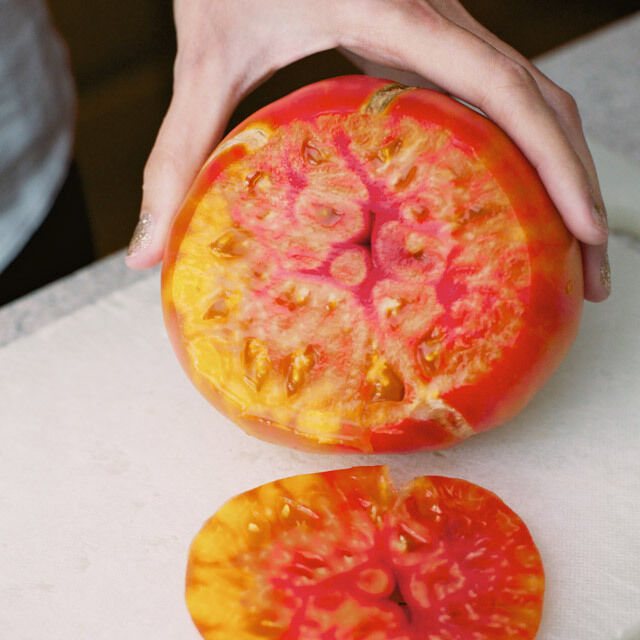

Speaking about the tomato of this variety, gardeners note: the yield will be higher if you feed not only adult bushes, but also seedlings. For this, a complex fertilizer for seedlings of tomatoes and peppers is suitable. The variety is quite unpretentious, it does not require any special care. The only feature is the need to tie up the bushes. Otherwise, they will either break or lie on the ground, which will lead to rotting of the fruit. The most convenient way, gardeners say, is to use trellises.
Tomato is not afraid of the main diseases of the nightshade family, pest attacks. Summer residents recommend planting the pineapple variety on their plot to those who either consume tomatoes in large quantities or sell them. The fact is that the yield of the variety is very high: it will not be possible to preserve them, and there are too many of them for homemade salads and tomato paste.
Tomato Pineapple appeared in the gardens of our compatriots not so long ago, but has already gained popularity. The reviews about it are enthusiastic, summer residents recommend this variety to their friends and neighbors. This is due to the fact that tomatoes are distinguished not only by their excellent taste, but also by long-term fruiting.
Preparing the soil for planting
For planting, the acidity of the soil is an important point. Many tomatoes prefer light soil and Black Pineapple as well. If the acidity of the soil is very high, then it will have to be limed every 3-5 years. It is forbidden to plant tomatoes in the place where eggplants or peppers used to grow. For them, a site is perfect where cucumbers, carrots, onions or cabbage have recently grown.
Humus or peat must be added to the ground. It also needs to be mixed with superphosphate and wood ash. So that during cultivation the vegetables do not start to hurt, before mixing all the fertilizers in the ground, it is frozen for a while. In order for tomatoes to grow and develop calmly, they need to add substrates, for example, the following:
- peat 7 parts;
- 1 part sawdust;
- 1 part wood ash;
- 3 lots of peat;
- 1 batch of humus;
- 0.5 sawdust and manure.
How to sow seeds and care for seedlings?
After a month, the seedlings can be planted in the greenhouse
An excellent harvest is obtained if the seedlings are grown correctly. First you need to check the germination of tomato seeds, so they are placed in salt water for 10 minutes. Those seeds that have drowned must be thrown away, and the rest are washed under running water. Tomato seeds are transferred to a towel and allowed to dry a little. The next day, they begin to be planted in special seedling pots.
Growing features
Despite the exotic appearance of the variety, the requirements for growing and caring for it are quite familiar to gardeners. The tomato is grown in seedlings. 50-60 days before planting in a permanent place, the seeds are sown in seedling pots to a depth of no more than 3 cm.
Before planting seedlings, a soil mixture is specially prepared. It is not recommended to plant the plant in the soil on which tomatoes or potatoes have grown before. The best precursors are carrots, cauliflower, cucumbers, dill, and parsley.
Black Pineapple Care
For tomatoes to thrive in the greenhouse and to grow properly, they need to be pruned. Excess leaves, unnecessary processes are removed, as they interfere with normal growth. But this should be done very carefully so as not to accidentally pull out something extra. First, the leaf itself begins to grow, and only then the stepson. It is located between the leaf and the peduncle. The gardener's stepson must remove to speed up ripening.
If you do not circumcise, and leave everything as it is, the bushes will overgrow and give green fruits. Pruning is carried out from the first brush, which immediately begins to bloom. To get a good harvest, leave 2 to 5 brushes. If you leave 2 brushes, the tomatoes will grow just giants, and if 5, then they will grow small.A person who grows tomatoes decides for himself how much fruit he needs.
Diseases of Black Tomatoes
To prevent the tomatoes from being eaten by parasites, it is necessary to carry out preventive measures. The most common diseases that settle on tomatoes are presented below.
- Blackfoot disease infects the stem of the plant, it begins to darken and thin out. The disease appears due to the large amount of moisture in the ground and in the air. To prevent it, it is necessary to ventilate the greenhouse and take care of the light.
- Another popular disease is top rot. It can appear from a lack of water in the ground and in the air. At the top of the bush, brown spots appear, which eventually attack the entire bush from top to roots. To prevent the disease, water the earth correctly and carry out ventilation.
- Streak is a virus that infects many plants, including tomatoes. To recognize the ailment, you don't need to make a lot of effort: brown stripes appear on the peduncles, and dark spots are sprinkled on the leaves. The plant will eventually die, since it is quite difficult to remove the streakiness. But there is one method, for this the plant is disinfected in a 1% solution of potassium permanganate.
- The last most common disease is fruit rot. It appears due to pathogens during ripening. Rot spreads to all fruits quickly enough. It all depends on temperature and humidity. To prevent it from appearing, it is necessary to often ventilate the greenhouse, and adhere to the correct temperature.
The nuances of cultivation in the open field and in the greenhouse
When growing any plant, there are certain nuances that must be taken into account.
The nuances of growing tomato Pineapple in the open field and in the greenhouse:
- Wrong choice of landing site. Choose a sunny area where nightshades have not previously been planted.
- Growing different crops together. For example: cucumbers and tomatoes cannot be planted in the same greenhouse, since they need completely different climatic conditions.
- Incorrect formation of tomatoes. Sometimes it is a pity for gardeners to remove side shoots, or they forget to pinch the top in time. The bush grows lush and weighty, but, unfortunately, does not bear fruit. A plant that was planted in open ground should not have more than 4 stems.
- Banner of the stem. When tying tomatoes, you need to be extremely careful not to damage the stem.
- Late pinching. If the side shoots are not removed in time, the yield will suffer. They need to be removed at a size of 3-4 cm, since they consume all nutrients and prevent the plant from developing.
- Eating disorder. Sometimes gardeners are fond of feeding the plant and instead of a large harvest they get a lush bush with large strong leaves. This is due to the large amount of manure.
- Closed greenhouse. If the greenhouse has high humidity and temperature, you should not close it. In tomatoes, pollen grains stick together and there is no normal pollination, respectively, the plant bears worse fruit.
- Late processing. Greenhouse tomatoes should be biologically treated every two weeks or after each harvest.
I plant the listed varieties without fail, but there are also those that I just liked, and I periodically grow them in a greenhouse, but I have not become a fan of them. Of the indeterminants, I like the carp varieties the most. Again, this is primarily because they look beautiful on a bush. There are only three such varieties, and for each there is a special reason to grow it.
Intuition F1 is a mid-ripening hybrid, but I would classify it as a late-ripening hybrid. Not only does it reach ripeness only by mid-August, but also biological maturity comes quite late. Some specimens of these tomatoes ripen even until the end of October.But, on the other hand, it is convenient because, as a result, we have our fresh tomatoes at home for a very long time. Therefore, I sow it in February.
Fig. 12. Photo of the end of July, and the fruits have not yet begun to pour.
But "Intuition F1" is very lying. This hybrid is great for freezing for future use. In winter, I make pizza and frittata with them, since they do not defrost like porridge, but perfectly retain their meatiness when slicing.
Fig. 13. The fruits are all even, beautiful.
Fig. 14. As such, I send the F1 Intuition to deep freeze.
“Scarlet candles” is a mid-ripening carp variety. They do not differ in special taste, but what a shape! Looks spectacular in blanks with cucumbers. However, for this I grow them. It's nice to admire such a jar later in the winter.
Fig. 15. Along the length of "Scarlet Candles" - almost like cucumbers for conservation.
Fig. 16. "Scarlet candles" look neat, all have a characteristic "nose".
"De barao" is quite late-ripening, I sow it before the bulk of tomatoes. I really like it in blanks, it does not crack and is very tasty, both fresh and pickled.
Fig. 17. "De Barao" is resistant to disease. I always plant it on the north side, tying it over the entrance to the greenhouse, because it is very tall, and the upper tier ripens even in the last decade of August, despite the first cold nights.
Fig. 18. The fruits are beautiful, all as one.
I have tried a great variety of salad varieties, I want to find everything the most delicious. Of the tomatoes of unusual colors, I really like the taste of "Malachite Box" and "Black Prince". Both are tall, require pinching, garters, formation of 1-2 stems, but the hassle is worth it, the fruits are great. "Black Prince" - dark burgundy at the stage of full ripeness.
Fig. 19. "Malachite box" in biological maturity - green.
Fig. 20. All these tomatoes of the "Malachite Box" are already ripe, even though they seem unripe in appearance.
Yellow giants are not inferior in taste, of which the most fleshy and delicious for me is "Yellow Truffle" - of an unusual shape, "Persimmon" - indeed, the pulp on a cut, like the fruit of the same name, "Golden King" and sweet, like a melon, " Golden bull ". Less impressed by "Golden Heart" and "Altai Yellow". But it should be noted that the keeping quality of yellow tomatoes is inferior to red ones.
Fig. 21. On the bush, everyone looks the same. This is the "Cardinal".
Fig. 22. Cardinal keeps well.
Fig. 23. "Canary Islands".
Fig. 24. In the foreground is Mazarin. It differs only in shape, in taste - like all other red-fruited.
Fig. 25. "Altai Reds", however, can be praised for their amicable maturation.
I would also like to note the pink-fruited tomatoes "Miracle of the Earth". If you are lucky with the summer, and it will not be very hot, then you can get a good harvest from this variety.
Fig. 26. "Miracle of the Earth" is also tall.
But, if there is not very good ventilation in the greenhouse, then this variety will give a characteristic light yellow border, I do not like it, and I cut it off before use.
Fig. 27. "Miracle of the Earth" - on the right. They are the same size as the "Red Giant" on the left.
Separately, it should be said about tall cherry tomatoes, for example, "Chio-chio-san", "Sweet-Cherry F1" and others. Yes, many of them are sweet, they look elegant both in the greenhouse and in salting, but many stepchildren are thrown away and require careful care. No matter how much I didn’t promise to plant them, but I still “break down”, I really want to admire the brush.
Fig. 28. "Red date", of course, delicious.
Fig. 29. "Goldilocks" is also good in taste, if you resist and do not eat it half-ripe - and it can be used in half-ripe form.
Among the tomatoes for growing outdoors, I liked only five. Although all tomatoes for open ground can be grown in a greenhouse, if there is space. It is simply more efficient to occupy the greenhouse not only in width, but also in height, therefore it is customary to place low varieties on the street, under temporary shelter or without it at all.
The Market King III F1 hybrid got its name for a reason.I grow it under cover and without, depending on how much space remains in the greenhouse after the main plantings. It is considered early maturing, although I would not say so. I plant it with pleasure, because in any summer - both cloudy and hot - it gives a stable harvest.
Fig. 30. “Market King III F1” produces lined fruits (in red basket).
Fig. 31. "Apple tree of Russia" on the bush.
Fig. 32. "Apple tree of Russia" is well stored, including frozen.
Fig. 33. "Buyan" is a long-known trouble-free variety for open ground.
Fig. 34. "Buyan" is good at salting.
Fig. 35. “Leningradsky Chill” I bought in an economical package - 200 seeds in one. It lived up to its name, did not freeze during frost, grew well both in the greenhouse and on the street.
Fig. 36. But the yellow-fruited variety "Wonder of the World" turned out to be the most cold-resistant for open ground. Ties just an incredible amount of fruits.
From the low ones I also tried "Kremlin F1", "Peach", "Orange Sun", "Darling", "Tiger", "Sanka". Despite the publicity, these varieties disappointed me.
And finally, the dwarfs. These tomatoes will suit even the laziest or busiest summer residents. They do not require garter, watering and, moreover, pinching.
Fig. 37. Dwarfs just need to mulch in mid-June and come to harvest in early August.
Fig. 38. Although, if you sow them at the end of February, you can harvest the first crop on July 1, as in this photo.
Fig. 39. They bear fruit all summer.
I tried SamRast, Florida Petit, Pygmy, Pinocchio, Balcony Duet - I liked them all.
Fig. 40. Florida Petite bore fruit even at home.
This year I will have only three new items: the tall "Shuntuk Giant" and the standard "Far North" and "Winter Cherry". For all of them, the reviews on the forum are good.
Do you have varieties of tomatoes that you must plant every year? How many are there, and what are they called?
02.22.16, NadyaNovosibirsk
seedling
,
tomato
,
summer resident's guide
- Lunar calendar for tomatoes for 2020
- Garter tomatoes
- Experiments with strawberries, from personal experience, seasons 2012-2014
And we respect every year the Khutorsky zasrlochny tomato. A truly versatile variety. Fresh, delicious, sweet, aromatic and salted, awesome. Its color is orange. It also adds beauty. The roots are powerful - they noticed when planting seedlings. But it needs to be tied.
I can’t find anywhere how to pinch a tomato. Beauty of the garden.
Thanks for the feedback! And here are my favorites: Fidelio Pink honey Pink elephant Batyania Mazarin Bull heart Keniksberg Eagle beak Cosmonaut Volkov - the variety on duty)) For many years I have been growing it, I made sure it tastes better! From salting Tolstoy - the beloved does not get sick, fruitful and good in salting!
Try to squander "Handsome". He will never leave your garden. Believe me!
Oh, you've done the job!
My favorite tomato varieties this year is Idol, medium-sized, very tasty, and fruitful. Planted on March 20 for seedlings, the first tomato was picked on June 20, it bears fruit to this day, i.e. already 3 months, there are still many fruits on the bushes. The most successful cherry variety is Black Cherry, very tasty and fruitful, the favorite tomato of my children. Also, along with Chkrnaya Vishngei, the Black bunch tomato is very sweet. The Lotto variety was planted for the first time this year, I liked it very much, fleshy fruits, good for salads and fresh, we will plant it in the future.
I planted my Intuition with the past 2020, I got it from friends. The plant is powerful, resistant to my main torment -KS. The brushes are abundant, beautiful and even ripen on the vine, but ... not edible. The entire middle of the fruit remains white, no matter how it is kept on the vine, I'm not talking about ripening. The longer you keep it on the vine, the harder the crust becomes, you just literally need to peel it off. There is no tomato taste, so some kind of grass. I will never plant again, despite all this "beauty"
If you really need
I will share tomato Alsou
gerbera11
Thanks for the link)
everyone praises the Favorite so much, somehow I’ll decide on it) the price is stopping) somehow I bought Martha F1, but she didn’t come up (
katlea
Thank you)
Sansei is an analogue of Alsou.

